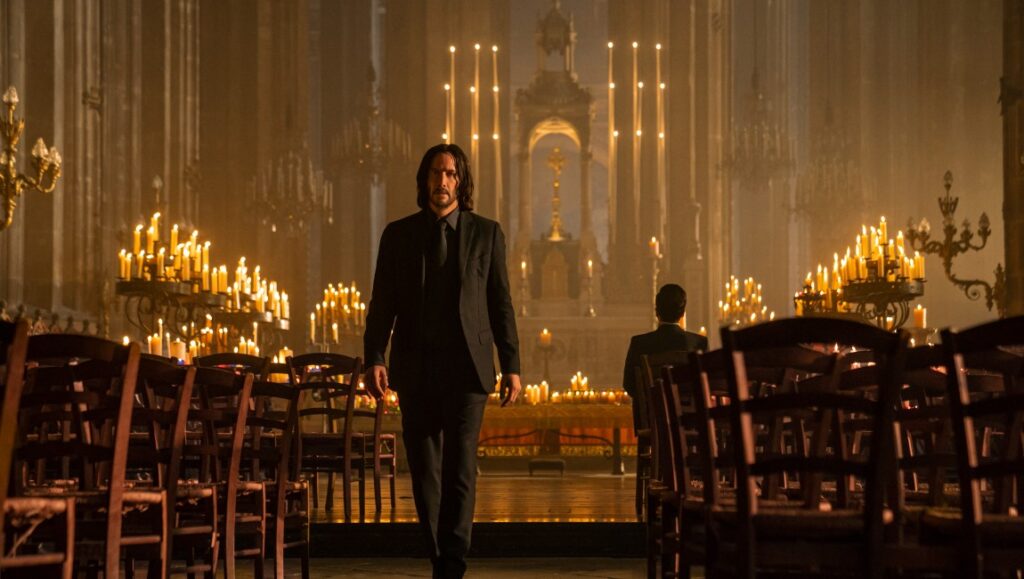It’s 2023, and while movies barely exist anymore, franchises certainly do. Hence John Wick: Chapter 4, a film that brings the whole John Wick series one step closer to something like the Fast and the Furious series, or — if Wick’s producers really wanted to dream — the white whale of the MCU. A John Wick spin-off just wrapped production, and a Mel Gibson-starring miniseries debuts later this year. But for now, we simply have star and executive producer Keanu Reeves, director Chad Stahelski, and Chapter 4 itself, a solid retread of the three previous films’ clever action, wryly comic universe, and (basically) simple story structure. “Solid” might not be stellar, but it’s also no easy feat to accomplish for a film with the dreadful number 4 appended to its name, and a bloated three-hour runtime to boot; plus, when the series has proved as consistently captivating and well-delivered as the Wick films have been up to this point, solid definitely means something.
When last we left Wick, he was waging war against an international network of assassins known only as the High Table. And when we find Wick again, lo, he’s still waging war against the High Table. Now, the shadowy organization has sent someone called the Marquis (Bill Skarsgård) after him, in turn hiring Wick’s ex-friend and blind ex-contract killer Caine (Donnie Yen) to take him out. Luckily, Wick is aided by Winston (Ian McShane), another former friend and former hotelier who turned enemy in the last film, but has since returned ally, who convinces Wick that his only hope is to rejoin one of the crime families that make up the High Table, in order to challenge the Marquis to a duel which, if Wick wins, will clear his name. Meanwhile, a mysterious figure calling himself “Nobody” also pursues Wick around with his dog in tow, alternatively aiding and attacking Wick as he sees fit. Oh, plus there’s ex-wrestler and DTV mainstay Scott Adkins, in a fat suit, as a German crime boss and club owner; Japanese-British pop star Rina Sawayama as a hotel manager who loses her father (Hiroyuki Sanada) to assassins; and the always great Laurence Fishburne, reprising his formerly inspired role as the Bowery King, the leader of a secret network of homeless assassins, who appears just so infrequently, randomly, and halfheartedly enough for you to think more about his paycheck and contractual objections than his performance.
Stahleski is certainly a skilled director, as evinced by almost any scene where someone lets off a bullet or throws a punch, but his ability to generate tension, engagement, and emotion on a narrative level is never more than functional and non-distracting. It might be something of a criticism to note that this critic never cared a lick about what happened in the plot, but it’s also a compliment to note that it doesn’t much matter — the action and revenge-story template are legible enough that the film actually thoroughly works on a scene by scene level. If anything, there’s even something comforting about Stahelski’s inability to convincingly pull off the heightened sense of scale and tacked-on epicness that’s tethered to the series’ ballooning budgets and runtimes. The Fast and Furious franchise may have eventually taken its small band of L.A. car thieves all the way to outer space, but Wick still finds Reeves punching, kicking, and shooting his way through the same sort of expressionistic night clubs and iconic urban locales that we’re used to from the start of this series.
To that end, Stahelski almost always keeps his camera at a medium distance when people are fighting — conveying as lucidly as possible the flow of action, while foregoing both panoramic wides that convey the scale of carnage and gritty close-ups that could develop psychological tension — and on the narrative plane, he’s not much different. Scenes work clearly and comprehensively so long as they stick to Wick’s simple, linear struggle to move up the ladder of the High Table and enact revenge. When the film suddenly drops Lawrence of Arabia quotes and randomly jumps to a horseback shootout in the Sahara, or whips together subplots about side characters stuck in endless cycles of revenge, it almost completely misses the mark. But when it sticks to simply exploring the many clever ways it can stage endless fight scenes in interesting locales, it soars.
Stahelski’s main gift is his knack for picking recognizable urban settings and exploring their physical dynamics in ways both familiar and wittily transcendent. From a circular car chase around the Arc de Triomphe that results in a lengthy brawl amidst traffic and numerous car crashes, to a shootout that wends its way through a derelict building and is delivered in a floorplan-style bird’s-eye view shot that creates some gut-churning kineticism, to a Sisyphean melee up the stairs of the Sacré-Cœur, and then down again, and then up again, John Wick: Chapter 4 showcases some of the most ingenious and exciting action scenes around. And importantly, it does so in ways that go beyond technical skill, arriving at something uniquely expressive.
Cinema has always had a knack for exploring the dynamics of our engagement with urban space, from Harold Lloyd dangling off a building to Adam Sandler dangling his cash out of a window in Uncut Gems. John Wick, then, is the rare action franchise to showcase such a sharp focus on physical reality in a cinema landscape that’s overladen with CGI. It could be better paced, sure, and could boast greater emotional depth, and could definitely shrug off some of its franchise bloat. But at the end of the day, it’s still a John Wick movie, and that is really starting to mean something.
Published as part of InRO Weekly — Volume 1, Issue 12.


Comments are closed.